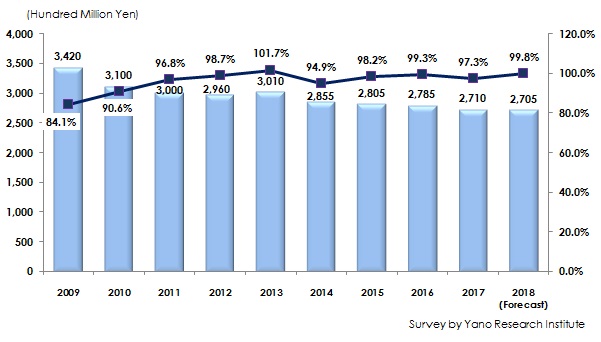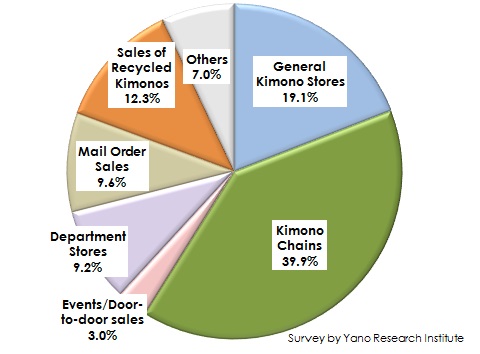Kimono Market in Japan: Key Research Findings 2018
Research Outline
- Research period: From November 2017 to March 2018
- Research targets: Manufacturers, wholesalers, retailers of kimonos and its peripheral goods
- Research methodologies: Face-to-face interviews by the expert researchers, mail–in questionnaire, and literature research
What is the Kimono Market?
The kimono market in this research indicates the market of pure-silk kimonos, pongee kimonos, “Obi (a band for kimono)”, recycled kimonos, accessories to wear with kimonos, “Yukata”, and kimonos made with synthetic fiber fabrics. The market size is calculated based on the retail value, and no rental kimonos are included.
Summary of Research Findings
- Domestic Kimono Market in 2017 Declined to 271.0 Billion Yen, 97.3% on Y-o-Y Basis
The domestic kimono retail market in 2016 scaled down to 271.0 billion yen, 97.3% of the size of the preceding year. In spite of negative social factors such as decreasing number of children and fewer people getting married (according to the data by MHLW), the market size has kept a certain level of size to hold on to a slight decrease in part because of favorable online sales and sales of recycled kimonos.
- Strong Recycling Sales and Online Sales Channels Continue
With regard to the kimono retail market in 2017 by channel, the sales of kimonos by means of recycling systems and mail orders have continued being favorable, whereas the sales at events and door-to-door have kept the same level as the previous year. Other than the above channels, however, the sales have not been good. Because of affordable prices and of being able to wear casually, recycled kimonos and Yukata, a kind of kimono made usually with cotton and worn during the summer, have attracted consumers to let the sales channels of recycling and mail-orders to positive growth.
- Consumer Preferences Diversified and Polarized, With Masterpieces Using Particular Materials and Dying Techniques Sometimes Demanded
Recycled kimonos, which are enjoyed equally with apparel fashion, and Yukata, available via internet, have been boosting the kimono market, because of their low prices and of the characteristics to allow consumers to wear casually.
On the other hand, there are some consumers who do not mind about the price and place importance on specially-made products with strong preferences for particular fabrics, materials and/or dying techniques that cannot be found so often and can be said as masterpieces. In consequence, consumer preferences have diversified, and also there is a tendency of the market becoming polarized.
- Figure 1: Transition of Size of Kimono Retail Market

- Figure 2: Kimono Retail Market Share by Sales Channel 2017
